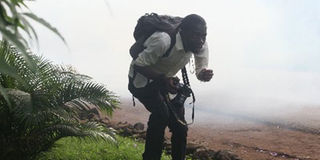Is Kenyan journalist an endangered species?

A photojournalist covering a demonstration in Kisumu on April 26, 2016. In the past few months, more than 30 journalists have been attacked in the line of duty in various parts of the country. PHOTO | FILE | NATION MEDIA GROUP
What you need to know:
Kenyan journalists have become vulnerable to threats and physical attacks from government agencies and the political class.
International rights and media organisations paint a grim picture of the media in Kenya.
- Media pundits say police and county officials have become a threat to independent media and professional journalism.
In the past few months, more than 30 journalists have been attacked in the line of duty in various parts of the country.
This is despite a guarantee of the freedom of expression and the media in the Constitution, expressed in laws such as the Media Council of Kenya Act 2013, Kenya Information and Communication Act 2013 and Freedom of Information Act 2016.
Several global media bodies have rated Kenya’s press freedom as being on a nosedive over the past decade. Research by the World Press Freedom Index covering 180 countries lumps Kenya in the bottom half of countries where press freedom is undermined.
DAMAGED
On January 30, the Ministry of Interior directed the Communications Authority of Kenya (CA) to switch off transmission by three leading TV stations — KTN News, Citizen and NTV — over their live coverage of the mock swearing-in ceremony of Opposition leader Raila Odinga.
Early last month, Standard correspondent James Omoro and Ally Abich of Royal Media Services were assaulted by police as they covered chaos at Homa Bay County Assembly. They also damaged and confiscated Mr Omoro’s equipment.
ASSAULTED
In July, two men appeared in a Kigumo court charged with assaulting Dennis Kabiru, an RMS journalist, as he and two other journalists covered a protest by parents over a Sh3,000 fine on their children at Elite Girls Academy in Maragua town, Murang’a County.
In March, anti-riot police attacked Citizen TV’s Stephen Letoo and NTV cameraman Robert Gichira as they covered a scuffle at the Jomo Kenyatta International Airport involving Canada-based lawyer-cum-politician, Dr Miguna Miguna.
BANNED
And in a bizarre case, the County Assembly of Tana River recently banned journalists from covering its proceedings.
Media pundits say the trend has made some police and county officials a threat to independent media and professional journalism.
A special report by the Committee to Protect Journalists (CPJ), ‘Broken Promises’, says “the government has introduced several Bills that undermine rather than enforce the principle of freedom of the media”.
THREATENED
Another, by Human Rights Watch (HRW), revealed that “the ability of journalists to report and comment freely continues to be undermined by State officials”.
In November, an audio recording emerged of a government official threatening KTN reporter Mark Nabiswa for covering a rally by Mr Odinga live. In January, an official in the Deputy President’s office, himself a former journalist, was heard on an audio tape threatening to have Nation journalist Justus Wanga sacked.
UNWARRANTED
Last year’s rankings by Reporters Without Borders eroded Kenya’s standing. Transparency International (TI), while releasing its 2017 Corruption Perception Index in March, also painted a grim picture of the media in Kenya.
Kenyan journalists have become vulnerable to threats and physical attacks from government agencies and the political class. Who will save this profession from these wanton, unwarranted attacks?
Mr Mdoe is a broadcast journalist in Nairobi. [email protected].





